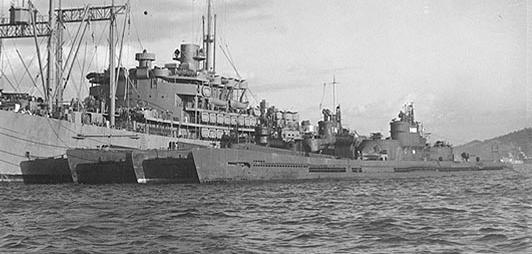![]() The Pacific War Online Encyclopedia
The Pacific War Online Encyclopedia
|
| Table of Contents |

Naval Historical Center #NH 97841. Cropped
by author.
|
Tonnage |
3530 tons standard displacement 5223 tons surfaced 6560 tons submerged |
|
Dimensions |
394'0" by 39'4" by 23'0" |
|
Maximum speed |
18.7 knots surfaced |
| Dive depth |
330 feet (100 m) |
|
Complement |
144 |
| Aircraft | 3 M6A Seiran seaplanes |
|
Armament |
1 5.5"/50
gun 3x3, 1x1 25mm/60 AA guns 8 21" (533 mm) torpedo tubes (20 torpedoes) |
| Machinery |
2-shaft diesel (7700 shp) or
electric (2400 shp) |
|
Range |
37,500 nautical miles (70,000 km) at 14 knots surfaced 30,000 nautical miles (56,000 km) at 16 knots surfaced 60 nautical miles (110km) at 3 knots submerged |
| Sensors |
Type 13 air search radar? Type 22 radar |
| Cargo |
4 aircraft torpedoes, 3 1760 lb (800 kg) bombs, and 12 550 lb (250 kg) bombs |
The Sen-tokus were a pet project of Admiral Yamamoto, who wished to build a flotilla of large aircraft-carrying submarines to strike at the cities of the U.S. East Coast. The Japanese had already built submarines capable of carrying a single small seaplane for reconnaissance, but Yamamoto's plan required submarines with tremendous range (40,000 nautical miles or 75,000 km) that could carry at least three combat aircraft. The submarines would need catapults at least 50 meters (55 yards) long, almost twice the length of any catapult previously installed on a submarine. The basic plan was completed by March 1942 and finalized on 17 May 1942. Construction of I-400 began on 25 April 1943 and the others soon followed. A total of 18 carrier submarines were planned, but following the death of Yamamoto in April 1943 much of the impetus behind the project was lost and nine of the submarines were canceled. Only five were laid down and, of these, only two were completed as carrier submarines. A third was converted to a gasoline tanker submarine, reflecting Japan's desperate supply situation towards the end of the war.
The submarines had impressive specifications,
being larger than most destroyers.
They were the largest submarines built before the era of nuclear
propulsion. The large conning tower straddled a huge aircraft hangar
tube capable
of holding three aircraft. These were Seiran
attack bombers specially
designed for service on the Sen-tokus.
The submarine hull had a sideways figure 8 form, rather than the
circular form of most submarines, that the Japanese believed improved
maneuverability. Nonetheless, members of the American prize crews that
took the submarines to Hawaii recall that they were underpowered and
very unmaneuverable, not surprising for submarines this large. The
ships were given an anechoic coating of asbestos mixed with gum and
binders of uncertain effectiveness and had snorkels installed
sometime around May 1945. They had two torpedo rooms, one above the other.
By the time construction was completed, the
mission of the submarines had changed from an attack on cities to an
attack on the Panama
Canal. They were to launch a squadron of aircraft from south of the
Panama Canal, which would fly east and north of the canal at low
altitude to evade radar. The
squadron would then turn
back south to attack the gates of the Gatun Locks on the Atlantic side
with torpedoes. The Japanese estimated that destruction of the gates
would disable the canal for six months. Due to a lack of skilled
torpedo pilots, the attack plan was subsequently changed so that only
two aircraft would use torpedoes and the rest would make a glide
bombing attack. In 1945 the plan was further changed to a kamikaze attack.
However, by the time the aircraft and submarines were ready, the fortunes of war had turned so badly against the Japanese that attacks on either the Panama Canal or the U.S. West Coast were ruled out as useless gestures. The mother submarines with their aircraft were deployed instead against Ulithi Atoll, the principal American carrier base in the western Pacific. However, the surrender order was received just before the attacks were launched, and the submarines were surrendered to the Americans while en route to Japan.
Only many decades later was it revealed that the
Seiran had been painted in
American colors for their final suicide
attack. Although American radar was equipped with IFF (Identification
Friend or Foe), the American markings and the planned approach route
(from the south) might have confused the defenders long enough for the
aircraft to reach the American carriers. The aircraft were all ditched
at sea before the Americans
boarded the submarines to avoid possible charges of violating the laws and customs of war.
We list only the submarines that were actually
completed.
|
Completed 1944-12-30 (Kure) |
||
| I-401 | Completed 1945-1-8 (Sasebo) | |
| I-402 | Completed 1945-7-24 (Sasebo) | Completed as a gasoline tanker submarine. |
References
Jentschura,
Jung, and Mickel (1977)
Nihon Kaigun
(accessed 2009-5-21)
The Pacific War Online Encyclopedia © 2007-2009, 2012 by Kent G. Budge. Index